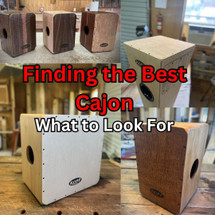Posted by Steve Head on 7th Sep 2024
Finding the Best Cajon: What to Look For and How to Choose the Right One for You
The cajon is a truly versatile instrument that has become a favorite in many musical genres worldwide. Whether you're playing flamenco, jazz, rock, or acoustic sets, the cajon adds depth and rhythm in a compact, portable format. But with so many options on the market, finding the best cajon for your needs can feel overwhelming.
In this post, I’ll walk you through what makes a cajon great, how to differentiate between various types, and what features to consider when selecting the right one. From Peruvian to Flamenco cajons, and modern snare cajons, I’ll help you make an informed choice.
What Makes the Best Cajon?
Choosing the best cajon depends on several factors: the quality of the materials, the craftsmanship, the type of cajon, and your specific playing needs. The best cajon for you might differ from what works for someone else, but there are key elements to consider across the board:
- Craftsmanship: Handcrafted cajons often provide better sound quality and durability. When choosing a cajon, look for well-constructed models with a solid frame and a high-quality tapa (the playing surface).
- Materials: The best cajons are typically made from high-quality hardwoods like birch, walnut, or maple. These materials not only affect the sound but also the durability and aesthetic of the cajon.
- Sound Quality: A good cajon should deliver a clear separation between bass and slap tones. Resonance and projection are key to ensuring that the cajon cuts through in live and recording environments.
Types of Cajons: Peruvian, Flamenco, and Snare Cajons
When shopping for a cajon, you'll quickly realize there are different types to choose from, each with its own unique sound and characteristics. The three most popular types are Peruvian cajons, Flamenco cajons, and snare cajons.
Peruvian Cajon: The Traditional Option
The Peruvian cajon is the original form of the instrument, dating back to the 18th century. It was created by enslaved Africans in Peru, who used crates as a substitute for drums that were banned by colonial authorities. The Peruvian cajon has a very simple, box-like design with no snare wires or strings inside.
Sound: The Peruvian cajon produces a natural, earthy tone with a deep, warm bass and crisp high-end slaps. Since it doesn't have snare wires or strings, the sound is pure, with minimal buzz or additional effects.
Best For: The Peruvian cajon is ideal for traditional folk music, world music, and any setting where a natural, unadorned drum sound is preferred. It's perfect for those looking for an authentic cajon sound.
Flamenco Cajon: The Spanish Twist
The Flamenco cajon, also known as a string cajon, was popularized in Spain in the 20th century. This type of cajon typically includes strings or guitar wires stretched across the tapa, which creates a snare-like sound when struck.
Sound: Flamenco cajons produce a sharper, more textured sound compared to their Peruvian counterparts. The strings or wires add a distinctive buzz, which gives the instrument a snare drum-like effect, perfect for genres that require more pronounced rhythmic accents.
Best For: The Flamenco cajon is commonly used in flamenco music, but its versatile sound makes it great for jazz, pop, and other modern music styles that need a punchier, snappier sound. It offers more rhythmic versatility for players who want to emulate a full drum kit sound with just one instrument.
Snare Cajon: The Modern Hybrid
The snare cajon takes inspiration from the drum kit's snare drum, featuring internal snare wires for added snap and responsiveness. These cajons are typically constructed with snares that can be adjusted or turned off, allowing you to switch between a traditional cajon sound and a more modern, snare-driven sound.
Sound: The snare cajon provides a crisp, tight snare effect along with deep bass tones. It’s a perfect balance for musicians who want more control over their sound, with the ability to switch between traditional and snare tones.
Best For: Snare cajons are great for drummers and percussionists who play in acoustic or stripped-down settings. They are ideal for genres like rock, pop, folk, and blues, where the snare effect adds depth and versatility to the rhythm.
How to Choose the Best Cajon for You
Now that you know the differences between the main types of cajons, how do you choose the best one for your needs? Here are some key factors to consider:
- Your Playing Style: If you’re playing traditional music or world music, a Peruvian cajon might suit your needs. For more contemporary styles like pop, jazz, or flamenco, a Flamenco cajon or snare cajon might be more appropriate.
- Sound Preferences: Do you prefer a pure, clean sound with no added effects, or do you like the buzz and snap of snare wires or strings? Think about the kind of sound that fits your music style best.
- Quality and Craftsmanship: Handcrafted cajons tend to provide better sound quality and durability. For example, the handcrafted cajons I create at Kopf Percussion focus on optimizing the tonal qualities of various woods to give each cajon a unique, resonant sound. If you're looking for a high-quality, American-made cajon, check out my American ToneWood Series.
- Budget: The best cajon for you should fit within your budget without compromising quality. While mass-produced cajons are more affordable, a handcrafted cajon, while more expensive, is often worth the investment for the quality and sound it provides.
Cajon Buyers Guide
If you're still unsure which cajon to choose, I recommend checking out this detailed cajon buyers guide from Cajon Master. It provides great insights on what to look for in a cajon, including types, materials, and key features to consider. This guide will help you make an informed decision when investing in your next cajon.
Conclusion: Finding Your Best Cajon
In the end, the best cajon is one that meets your specific needs as a musician. Whether you prefer the earthy tones of a Peruvian cajon, the sharp snare-like sound of a Flamenco cajon, or the versatility of a modern snare cajon, it’s important to choose an instrument that matches your style and sound preferences.
At Kopf Percussion, I take pride in crafting high-quality cajons that offer a range of sounds, perfect for any musician. If you're interested in learning more about my handcrafted cajons, feel free to explore my full collection. Whatever your choice, make sure the cajon you pick is one that inspires your creativity and helps you make the best music possible.

